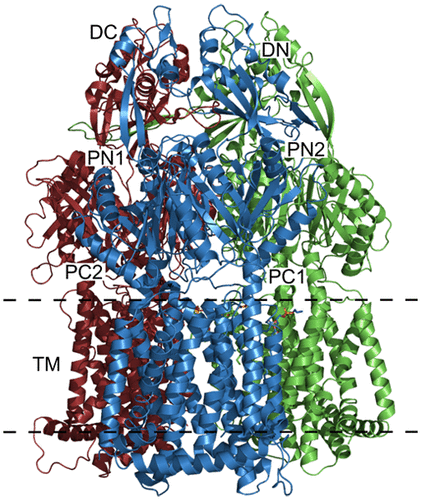当前位置:
X-MOL 学术
›
Chem. Rev.
›
论文详情
Our official English website, www.x-mol.net, welcomes your
feedback! (Note: you will need to create a separate account there.)
Structural and Functional Diversity of Resistance–Nodulation–Cell Division Transporters
Chemical Reviews ( IF 51.4 ) Pub Date : 2020-11-19 , DOI: 10.1021/acs.chemrev.0c00621 Philip A Klenotic 1 , Mitchell A Moseng 1 , Christopher E Morgan 1 , Edward W Yu 1
Chemical Reviews ( IF 51.4 ) Pub Date : 2020-11-19 , DOI: 10.1021/acs.chemrev.0c00621 Philip A Klenotic 1 , Mitchell A Moseng 1 , Christopher E Morgan 1 , Edward W Yu 1
Affiliation

|
Multidrug resistant (MDR) bacteria are a global threat with many common infections becoming increasingly difficult to eliminate. While significant effort has gone into the development of potent biocides, the effectiveness of many first-line antibiotics has been diminished due to adaptive resistance mechanisms. Bacterial membrane proteins belonging to the resistance–nodulation–cell division (RND) superfamily play significant roles in mediating bacterial resistance to antimicrobials. They participate in multidrug efflux and cell wall biogenesis to transform bacterial pathogens into “superbugs” that are resistant even to last resort antibiotics. In this review, we summarize the RND superfamily of efflux transporters with a primary focus on the assembly and function of the inner membrane pumps. These pumps are critical for extrusion of antibiotics from the cell as well as the transport of lipid moieties to the outer membrane to establish membrane rigidity and stability. We analyze recently solved structures of bacterial inner membrane efflux pumps as to how they bind and transport their substrates. Our cumulative data indicate that these RND membrane proteins are able to utilize different oligomerization states to achieve particular activities, including forming MDR pumps and cell wall remodeling machineries, to ensure bacterial survival. This mechanistic insight, combined with simulated docking techniques, allows for the design and optimization of new efflux pump inhibitors to more effectively treat infections that today are difficult or impossible to cure.
中文翻译:

抗性-结瘤-细胞分裂转运蛋白的结构和功能多样性
多重耐药 (MDR) 细菌是一种全球性威胁,许多常见感染变得越来越难以消除。尽管人们在开发强效杀菌剂方面投入了大量精力,但由于适应性耐药机制,许多一线抗生素的有效性已经减弱。属于耐药-结节-细胞分裂(RND)超家族的细菌膜蛋白在介导细菌对抗菌药物的耐药性中发挥着重要作用。它们参与多药外流和细胞壁生物发生,将细菌病原体转化为“超级细菌”,甚至对最后的抗生素具有抗药性。在这篇综述中,我们总结了外排转运蛋白的 RND 超家族,主要关注内膜泵的组装和功能。这些泵对于从细胞中挤出抗生素以及将脂质部分运输到外膜以建立膜的刚性和稳定性至关重要。我们分析了最近解决的细菌内膜外排泵的结构,了解它们如何结合和运输其底物。我们的累积数据表明,这些 RND 膜蛋白能够利用不同的寡聚状态来实现特定的活性,包括形成 MDR 泵和细胞壁重塑机制,以确保细菌的生存。这种机制洞察与模拟对接技术相结合,可以设计和优化新的外排泵抑制剂,以更有效地治疗当今难以或不可能治愈的感染。
更新日期:2020-11-19
中文翻译:

抗性-结瘤-细胞分裂转运蛋白的结构和功能多样性
多重耐药 (MDR) 细菌是一种全球性威胁,许多常见感染变得越来越难以消除。尽管人们在开发强效杀菌剂方面投入了大量精力,但由于适应性耐药机制,许多一线抗生素的有效性已经减弱。属于耐药-结节-细胞分裂(RND)超家族的细菌膜蛋白在介导细菌对抗菌药物的耐药性中发挥着重要作用。它们参与多药外流和细胞壁生物发生,将细菌病原体转化为“超级细菌”,甚至对最后的抗生素具有抗药性。在这篇综述中,我们总结了外排转运蛋白的 RND 超家族,主要关注内膜泵的组装和功能。这些泵对于从细胞中挤出抗生素以及将脂质部分运输到外膜以建立膜的刚性和稳定性至关重要。我们分析了最近解决的细菌内膜外排泵的结构,了解它们如何结合和运输其底物。我们的累积数据表明,这些 RND 膜蛋白能够利用不同的寡聚状态来实现特定的活性,包括形成 MDR 泵和细胞壁重塑机制,以确保细菌的生存。这种机制洞察与模拟对接技术相结合,可以设计和优化新的外排泵抑制剂,以更有效地治疗当今难以或不可能治愈的感染。











































 京公网安备 11010802027423号
京公网安备 11010802027423号